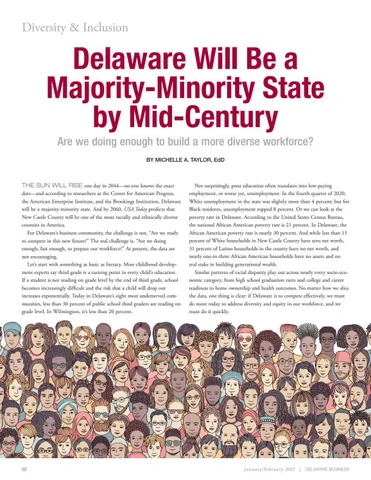Diversity & Inclusion
Delaware Will Be a Majority-Minority State by Mid-Century Are we doing enough to build a more diverse workforce? BY MICHELLE A. TAYLOR, EdD
THE SUN WILL RISE one day in 2044—no one knows the exact date—and according to researchers at the Center for American Progress, the American Enterprise Institute, and the Brookings Institution, Delaware will be a majority-minority state. And by 2060, USA Today predicts that New Castle County will be one of the most racially and ethnically diverse counties in America. For Delaware’s business community, the challenge is not, “Are we ready to compete in this new future?” The real challenge is, “Are we doing enough, fast enough, to prepare our workforce?” At present, the data are not encouraging. Let’s start with something as basic as literacy. Most childhood development experts say third grade is a turning point in every child’s education. If a student is not reading on grade level by the end of third grade, school becomes increasingly difficult and the risk that a child will drop out increases exponentially. Today in Delaware’s eight most underserved communities, less than 30 percent of public school third graders are reading on grade level. In Wilmington, it’s less than 20 percent.
52
Not surprisingly, poor education often translates into low-paying employment, or worse yet, unemployment. In the fourth quarter of 2020, White unemployment in the state was slightly more than 4 percent; but for Black residents, unemployment topped 8 percent. Or we can look at the poverty rate in Delaware. According to the United States Census Bureau, the national African American poverty rate is 21 percent. In Delaware, the African American poverty rate is nearly 30 percent. And while less than 15 percent of White households in New Castle County have zero net worth, 31 percent of Latino households in the county have no net worth, and nearly one-in-three African American households have no assets and no real stake in building generational wealth. Similar patterns of racial disparity play out across nearly every socio-economic category, from high school graduation rates and college and career readiness to home ownership and health outcomes. No matter how we slice the data, one thing is clear: if Delaware is to compete effectively, we must do more today to address diversity and equity in our workforce, and we must do it quickly.
Jan uar y / Fe b r uar y 2022 | DELAWARE BUSINESS




































